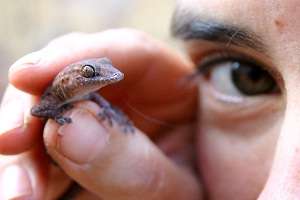Dr Pepper says more research is needed on these populations to see whether they are true ‘short range endemics’. Credit: Dr Pepper with gecko, Karen Culle
Researchers investigating the relationship between biogeography and endemism in the Pilbara have uncovered two surprising discoveries.
The first, that genetic diversity within Pilbara gecko taxa is substantially greater than previously thought, and the second, that genetic patterns across gecko species appear to be shaped by historic landscape and geographical processes of the region.
For lead author Mitzy Pepper, postdoctoral researcher from ANU's Evolution, Ecology & Genetics Division, the Pilbara is the perfect place for discovery.
"There is no more exciting place on Earth than the Pilbara with its magnificent and ancient landscape, and evolutionary relics persisting there, across all animal and plant communities," Dr Pepper says.
The study examined the genetic variation of seven species of Pilbara gecko, and how this variation is distributed across the Pilbara landscape.
The researchers assessed fine-scale phylogenetic structures of the geckos using genetic material stored in the WA Museum.
A significant, previously unknown genetic diversity within the geckos emerged from the data.
"One [gecko] in particular, the spotted Dtella (Gehyra punctata), is so genetically diverse it is what we call a 'species complex'… it is made up of many genetically distinct populations that look similar, so up until now we have considered them a single species," Dr Pepper says.
The researchers were also interested in assessing whether variations in the geology and topography of the Pilbara had influenced the genetic diversity of the geckos.
Three previously hypothesised biogeographical regions of the Pilbara were assessed—the divide between northern granite/greenstone terrain and the southern Hamersley Basin; the four subregions developed by the Interim Biogeographic Regionalisation for Australia (IBRA); and north and south of the Fortescue River valley which cuts through the centre of the Pilbara.
A biogeographical pattern in genetic differentiation of geckos across the Pilbara was uncovered.
Two consistent genetic partitions emerged between the north and south of the Fortescue River valley, as well as slighter distinction between the east and west portions of the northern subregion.
"The fact that these patterns are shared across different species suggests they were shaped by similar environmental and landscape processes [such as] mountain ranges or river systems, which at some point stopped populations from crossing into neighbouring regions," Dr Pepper says.
"We need to do further research on these populations to see whether they are true 'short range endemics' or whether their distributions are more extensive than we know at the moment."
Dr Pepper highlights the importance of discovering which areas contain the most genetic variation so these can be managed in conjunction with the resource industry.
More information: onlinelibrary.wiley.com/doi/10 … 1/jbi.12080/abstract
Provided by Science Network WA
























